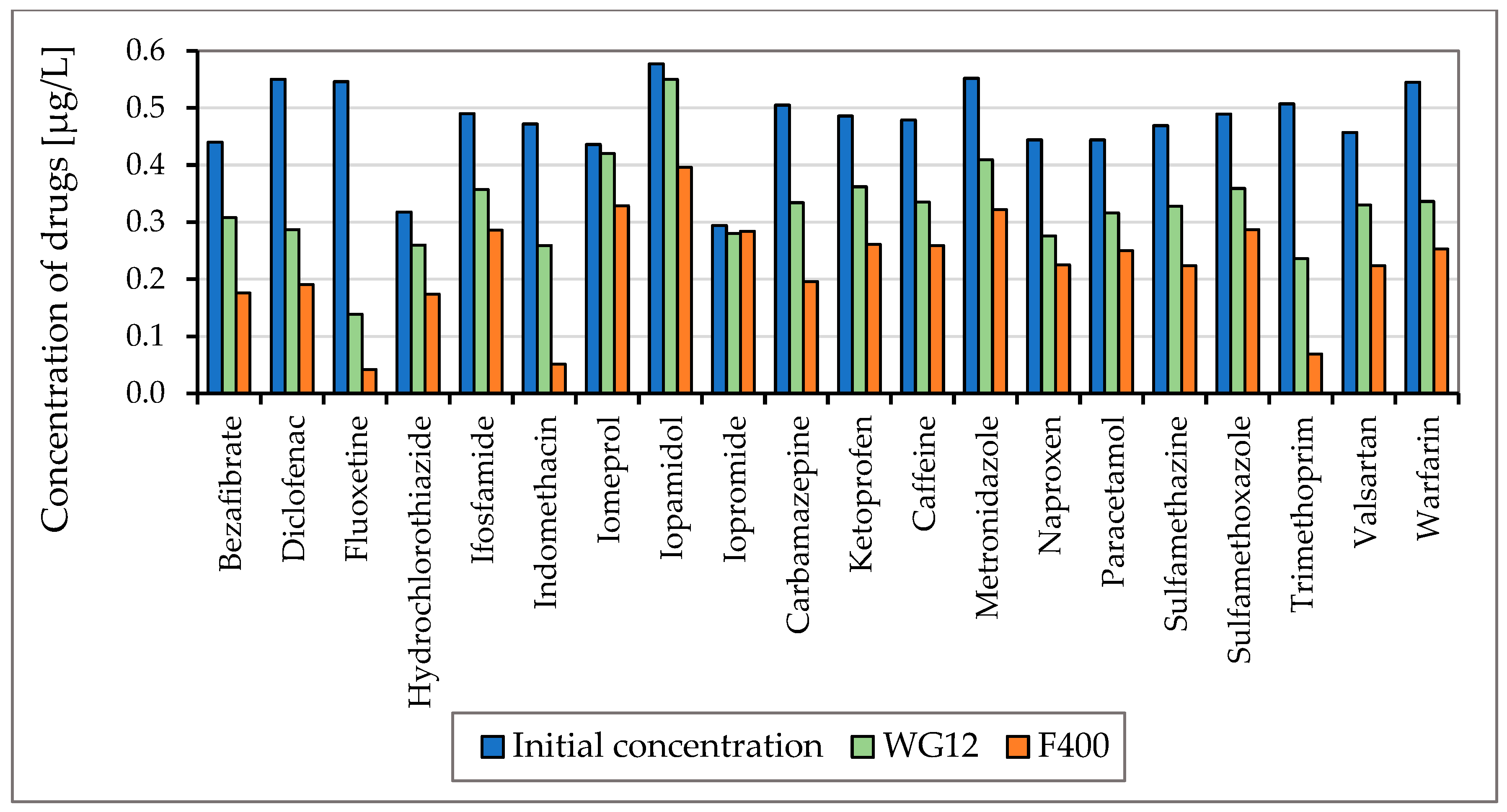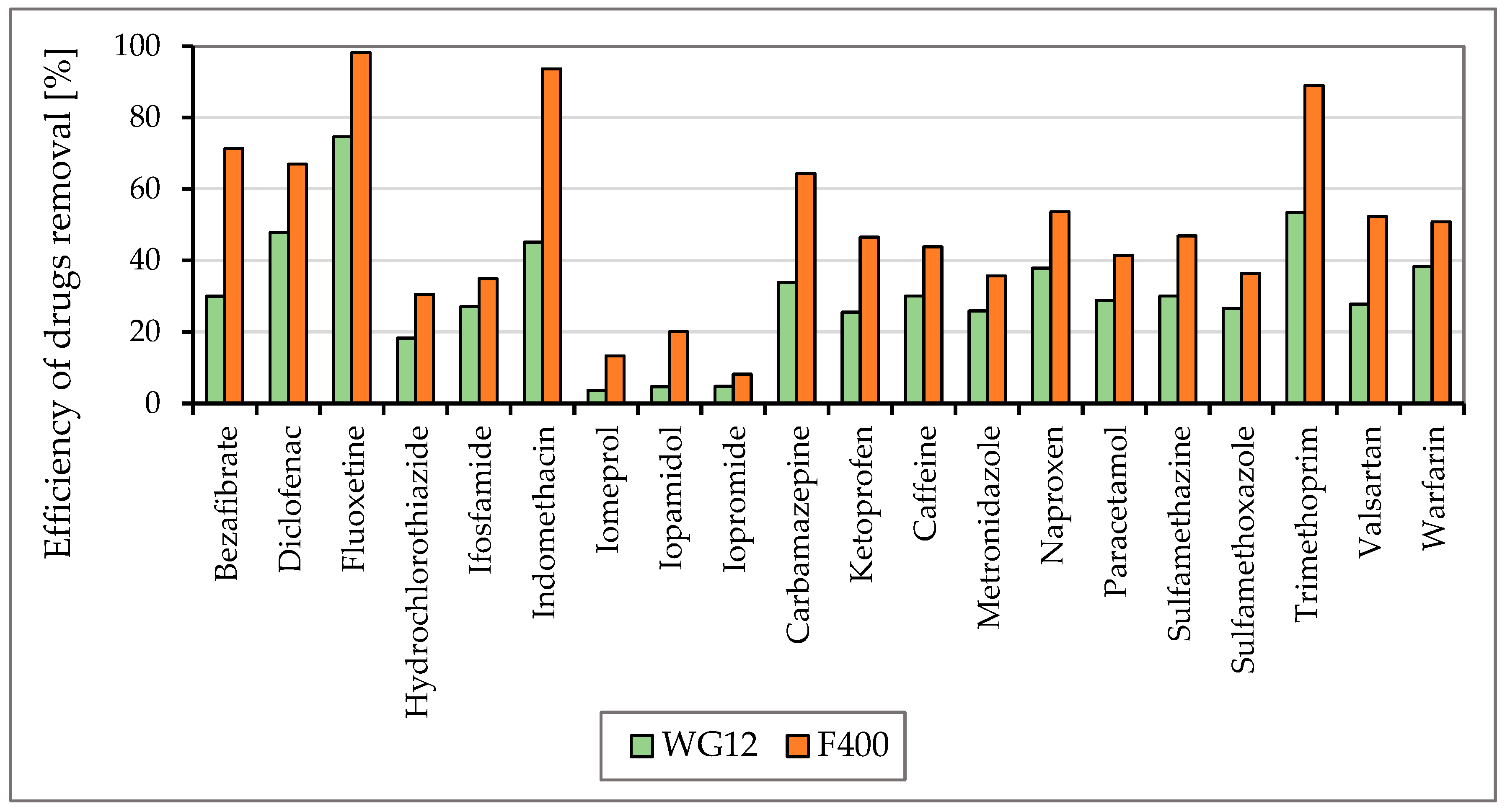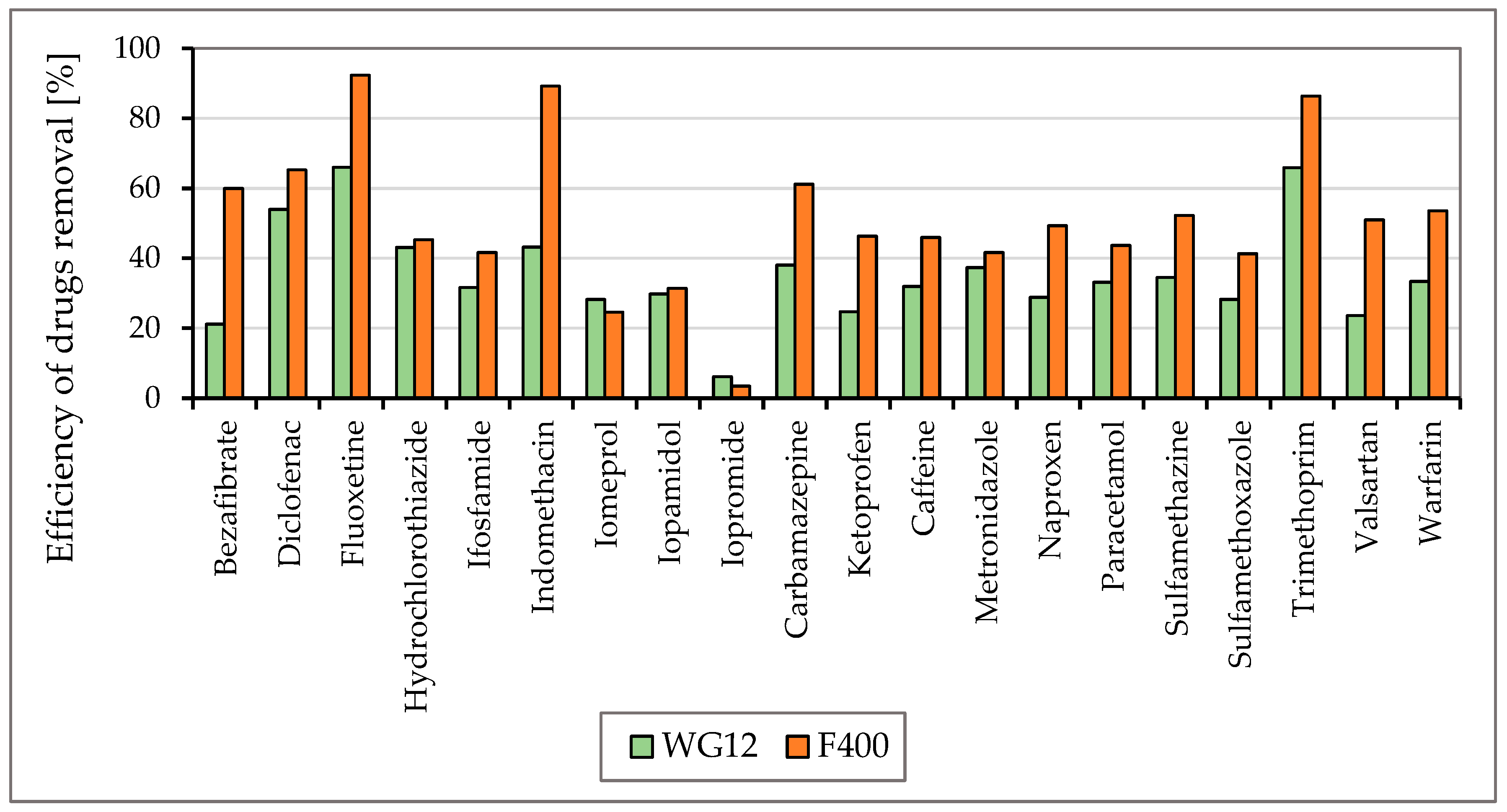The Removal of Selected Pharmaceuticals from Water by Adsorption with Granular Activated Carbons †
Abstract
:1. Introduction
1.1. Methods of Removal of Pharmaceuticals from Water
1.2. Pharmaceuticals Used in This Research
2. Materials and Methods
3. Results and Discussion
4. Conclusions
Author Contributions
Funding
Institutional Review Board Statement
Informed Consent Statement
Data Availability Statement
Acknowledgments
Conflicts of Interest
References
- Rosenfeld, P.; Feng, L. Risk of Hazardous Wastes, 1st ed.; Elsevier: Amsterdam, The Netherlands, 2011; p. 472. [Google Scholar]
- Yang, Y.; Ok, Y.S.; Kim, K.-H.; Kwon, E.E.; Tsang, Y.F. Occurrences and removal of pharmaceuticals and personal care products (PPCPs) in drinking water and water/sewage treatment plants: A review. Sci. Total Environ. 2017, 596–597, 303–320. [Google Scholar] [CrossRef] [PubMed]
- Fent, K.; Weston, A.A.; Caminada, D. Ecotoxicology of human pharmaceuticals. Aquat. Toxicol. 2006, 76, 122–159. [Google Scholar] [CrossRef] [PubMed]
- European Commission. Communication from the Commission to the European Parliament, the Council and the European Economic and Social Committee: European Union Strategic Approach to Pharmaceuticals in the Environment. Available online: https://eur-lex.europa.eu/legal-content/EN/TXT/HTML/?uri=CELEX:52019DC0128&from=SK (accessed on 2 July 2023).
- WHO. Pharmaceuticals in Drinking-Water; WHO Press: Geneva, Switzerland, 2012. [Google Scholar]
- Aus der Beek, T.; Weber, F.-A.; Bergmann, A.; Hickmann, S.; Ebert, I.; Hein, A.; Küster, A. Pharmaceuticals in the environment: Global occurrences and perspectives. Environ. Toxicol. Chem. 2016, 35, 823–835. [Google Scholar] [CrossRef] [PubMed]
- Mackuľak, T.; Czölderová, M.; Grabic, R.; Bodík, I.; Vojs-Staňová, A.; Žabka, D.; Horáková, I. Výskyt liečiv a drog v povrchových vodách Slovenska. In Proceedings of the 38th International Scientific Symposium, Svit, Slovakia, 13–15 June 2018; pp. 91–105. [Google Scholar]
- Baresel, C.; Ek, M.; Ejhed, H.; Allard, A.S.; Magnér, J.; Dahlgren, L.; Westling, K.; Wahlberg, C.; Fortkamp, U.; Söhr, S.; et al. Sustainable treatment systems for removal of pharmaceutical residues and other priority persistent substances. Water Sci. Technol. 2019, 79, 537–543. [Google Scholar] [CrossRef] [PubMed]
- Wang, J.; Bai, Z. Fe-based catalysts for heterogeneous catalytic ozonation of emerging contaminants in water and wastewater. Chem. Eng. J. 2017, 312, 79–98. [Google Scholar] [CrossRef]
- Cuerda-Correa, E.M.; Alexandre-Franco, M.F.; Fernández-González, C. Advanced Oxidation Processes for the Removal of Antibiotics from Water. An Overview. Water 2020, 12, 102. [Google Scholar] [CrossRef]
- Vieno, N.; Tuhkanen, T.; Kronberg, L. Removal of Pharmaceuticals in Drinking Water Treatment: Effect of Chemical Coagulation. Environ. Technol. 2006, 27, 183–192. [Google Scholar] [CrossRef] [PubMed]
- Kabelíková, E. Sledování Účinnosti Vybraných Adsorbentů na Odstraňování Mikropolutantů z Pitné Vody. Diploma Thesis, VUT Brno, Brno, Czech Republic, 2019. [Google Scholar]
- Moravčíková, S. Sledování Účinnosti Odstraňování Léčiva z Vody Vybranými Adsorbenty. Diploma Thesis, VUT Brno, Brno, Czech Republic, 2020. [Google Scholar]
- Vieno, N.M.; Härkki, H.; Tuhkanen, T.; Kronberg, L. Occurrence of pharmaceuticals in river water and their elimination in a pilot-scale drinking water treatment plant. Environ. Sci. Technol. 2007, 41, 5077–5084. [Google Scholar] [CrossRef] [PubMed]
- Nam, S.W.; Choi, D.J.; Kim, S.K.; Her, N.; Zoh, K.D. Adsorption characteristics of selected hydrophilic and hydrophobic micropollutants in water using activated carbon. J. Hazard. Mater. 2014, 270, 144–152. [Google Scholar] [CrossRef] [PubMed]
- Katsigiannis, A.; Noutsopoulos, C.; Mantziaras, J.; Gioldasi, M. Removal of emerging pollutants through Granular Activated Carbon. Chem. Eng. J. 2015, 280, 49–57. [Google Scholar] [CrossRef]
- Licona, K.P.M.; Geaquinto, L.R.d.O.; Nicolini, J.V.; Figueiredo, N.G.; Chiapetta, S.C.; Habert, A.C.; Yokoyama, L. Assessing potential of nanofiltration and reverse osmosis for removal of toxic pharmaceuticals from water. J. Water Process Eng. 2018, 25, 195–204. [Google Scholar] [CrossRef]
- Lu, Z.-Y.; Ma, Y.-L.; Zhang, J.-T.; Fan, N.-S.; Huang, B.-C.; Jin, R.-C. A critical review of antibiotic removal strategies: Performance and mechanisms. J. Water Process Eng. 2020, 38, 101681. [Google Scholar] [CrossRef]
- Homem, V.; Santos, L. Degradation and removal methods of antibiotics from aqueous matrices—A review. J. Environ. Manag. 2011, 92, 2304–2347. [Google Scholar] [CrossRef] [PubMed]
- Pertile, E.; Dvorský, T.; Václavík, V.; Heviánková, S. Use of Different Types of Biosorbents to Remove Cr (VI) from Aqueous Solution. Life 2021, 11, 240. [Google Scholar] [CrossRef] [PubMed]
- Pertile, E.; Václavík, V.; Dvorský, T.; Heviánková, S. The Removal of Residual Concentration of Hazardous Metals in Wastewater from a Neutralization Station Using Biosorbent—A Case Study Company Gutra, Czech Republic. Int. J. Environ. Res. Public Health 2020, 17, 7225. [Google Scholar] [CrossRef] [PubMed]
- Wang, X.; Yin, R.; Zeng, L.; Zhu, M. A review of graphene-based nanomaterials for removal of antibiotics from aqueous environments. Environ. Pollut. 2019, 253, 100–110. [Google Scholar] [CrossRef] [PubMed]
- Zhang, A.; Li, X.; Xing, J.; Xu, G. Adsorption of potentially toxic elements in water by modified biochar: A review. J. Environ. Chem. Eng. 2020, 8, 104196. [Google Scholar] [CrossRef]
- Kim, S.; Chu, K.-H.; Al-Hamadani, Y.A.J.; Park, C.-M.; Jang, M.; Kim, D.-H.; Yu, M.; Heo, J.; Yoon, Y. Removal of contaminants of emerging concern by membranes in water and wastewater: A review. Chem. Eng. J. 2018, 335, 896–914. [Google Scholar] [CrossRef]
- Ilavský, J.; Barloková, D.; Marton, M. Removal of Specific Pharmaceuticals from Water using Activated Carbon. IOP Conf. Ser. Earth Environ. Sci. 2021, 906, 012065. [Google Scholar] [CrossRef]






| Parameter | WG12 | F400 |
|---|---|---|
| Form | pellet | granular |
| Iodine number [mg·g−1] | min. 1000 | min. 1050 |
| Methylene blue [mg·g−1] | min. 30 | min. 260 |
| Specific surface (BET) [m2·g−1] | min 1000 | min 1050 |
| Particle size [mm] | 1.0–1.5 | 0.42–1.68 |
| Operational density [g·cm−3] | 0.450 ± 30 | 0.425 |
| Abrasion [-] | min. 85 | min. 75 |
| Hardness [-] | min. 95 | min. 95 |
| Uniformity coefficient | max. 1.3 | max. 1.9 |
| Moisture [wt.%] | max. 2 | max. 2 |
Disclaimer/Publisher’s Note: The statements, opinions and data contained in all publications are solely those of the individual author(s) and contributor(s) and not of MDPI and/or the editor(s). MDPI and/or the editor(s) disclaim responsibility for any injury to people or property resulting from any ideas, methods, instructions or products referred to in the content. |
© 2023 by the authors. Licensee MDPI, Basel, Switzerland. This article is an open access article distributed under the terms and conditions of the Creative Commons Attribution (CC BY) license (https://creativecommons.org/licenses/by/4.0/).
Share and Cite
Ilavský, J.; Barloková, D. The Removal of Selected Pharmaceuticals from Water by Adsorption with Granular Activated Carbons. Eng. Proc. 2023, 57, 33. https://doi.org/10.3390/engproc2023057033
Ilavský J, Barloková D. The Removal of Selected Pharmaceuticals from Water by Adsorption with Granular Activated Carbons. Engineering Proceedings. 2023; 57(1):33. https://doi.org/10.3390/engproc2023057033
Chicago/Turabian StyleIlavský, Ján, and Danka Barloková. 2023. "The Removal of Selected Pharmaceuticals from Water by Adsorption with Granular Activated Carbons" Engineering Proceedings 57, no. 1: 33. https://doi.org/10.3390/engproc2023057033






